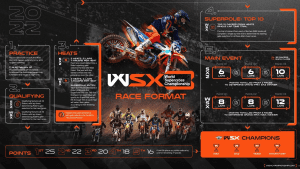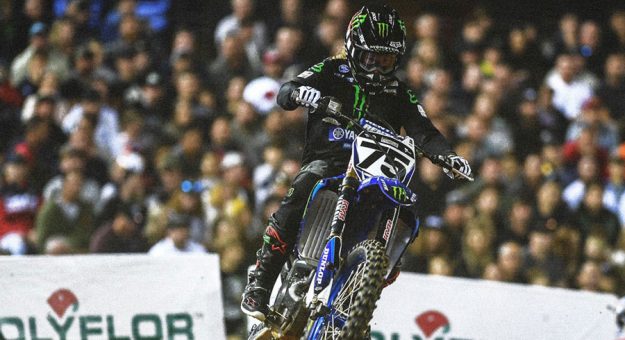Supercross was born in the United States on July 8, 1972.
Deemed the “Superbowl of Motocross,” the inaugural event was held inside the L.A. Memorial Coliseum in front of nearly 30,000 people who witnessed daredevil athletes challenge a man-made stadium course on dirt bikes for the first time in history.
It was such a success that an official Supercross season was introduced two years later, with AMA the sanctioning body. It later incorporated sanctioning by the Fédération Internationale de Motocyclisme in 2002 and partnered with FELD Entertainment in 2008 to further promote the series.
All the while, Supercross has caught fire with American fans.
Trailblazing athletes such as Bob Hannah, Jeremy McGrath and Ricky Carmichael have been engraved as legends of the sport through each era of its history. However, Supercross has been changing since that first race in 1972.
The 500cc bikes of the premier class eventually gave way to the 450cc bikes competitors ride today, the original three-moto format morphed into an intense night of heat races and main events, and even the athletes launched themselves to new levels of training and competition.

Fifty years later, Supercross is facing a new opportunity for change.
Adam Bailey and Ryan Sanderson are taking the sport international with the introduction of the World Supercross Championship.
In May 2021, Monster Energy AMA Supercross separated from the FIM, leaving the door open for a new series to take over the sanctioning agreement. Bailey and Sanderson — managing directors at SX Global and the duo responsible for creating the Aus-X Open — jumped at the chance after years of dreaming about the worldwide potential of Supercross.
“We kind of had this vision for a global, international expansion of Supercross,” Bailey said. “The U.S. Supercross championship is so huge and so successful, but it doesn’t leave the West.”
By August of 2021, the two were presenting their plan for a world supercross series to the FIM. On Christmas Eve, they officially brought on an investment partner — Mubadala Capital — and shortly afterward, signed a 10-year deal that secured FIM sanctioning for the FIM World Supercross Championship.
“Born in America, delivered to the world. That’s our motto,” said Nathan Prendergast, head of TV and broadcast at SX Global.
While paying homage to the lengthy history of Supercross is important to the team, WSX has been a blank slate for Prendergast when it comes to developing the broadcast.
The tentative television audience includes nearly 50 countries and more than 200 million homes, most of which are not familiar with Supercross. Prendergast believes that his role starts with educating the audience about the sport through detailed graphics and illustrative video features.
To excite existing fans, WSX is introducing technical innovations to better match the production of other global sports, such as Formula 1 and MotoGP.
“Supercross is obviously, already a very exciting product. It’s visually spectacular, essentially an extreme sport that you race,” Prendergast said. But from a broadcast perspective, he added, “There is some basics that are a part of other global motorsports products that have just been missing from Supercross.”
To name a few, the broadcast will include live, on-board cameras; pit-to-bike radio feeds; as well as multi-cameras on bikes that involve forward facing gimbles, rear shots and rider shots.
Prendergast is also working on collecting data from the bikes to communicate speeds, jump heights and similar information to the audience. The in-person event experience has also been enhanced, with the addition of live musical performances, freestyle motocross attractions and pyrotechnics.
“We’re uniquely positioned to bring motorsports inside a stadium,” Sanderson said. In comparison to Formula 1 or MotoGP, one of the selling points of Supercross is that “as a fan, you can see the whole sport in front of you.”
There are three rounds of the World Supercross Championship scheduled for this year, the first of which is the Oct. 8 British Grand Prix in Cardiff, United Kingdom.
While many elements of the series and how it is captured will be new, there is also familiarity to be found.
Longtime play-by-player caller of Monster Energy Supercross Ralph Sheheen and 12-year color commentator Jeff Emig will once again be joining forces in the broadcast booth for WSX.
Bailey recognizes the dynamic duo as fan favorites. Ever since Sheheen’s departure after 15 years of being the lead announcer for the series in 2021, Bailey believes the fans have been waiting for his return.
“For me, it’s a no-brainer,” Bailey said. “We’re in a really lucky position, where it’s kind of like a blank sheet of paper. And, if you have this sport you love, what would you do to it to make it better? And we literally just started with that.”

Though the fans have been a crucial consideration in the series development, there has also been a considerable financial focus placed on the riders and teams.
There has been $50 million dedicated to supporting the teams and riders over the next five years for appearance fees, sign-on fees as well as freight and logistics. Additionally, there is more than $15 million in prize money up for grabs over those years.
The goal is to keep the teams financially viable and give them the opportunity to build a legacy around their name and franchise. As it stands in America, the only teams that see a commercial return on their investment in the sport are typically factory manufacturers, innately reducing the longevity of privately owned teams.
Bailey and Sanderson have developed a model that features 10 exclusive teams and 40 contracted riders. Each team will have two riders in the premier WSX class (450cc) and two in the SX2 class (250cc).
At the conclusion of the series, four world champions will be crowned. A manufacturers’ champion, a teams’ champion and an individual champion for each of the respective classes.
Riders in both the WSX and SX2 classes will accumulate points for their team.
“We love and respect the two different classes, they’re so close to equal already,” Sanderson said. Accordingly, there are no limitations on how long a rider can stay in the SX2 class.
Sanderson and Bailey also recognize the commitment of Supercross riders and the flat-out intensity of what they accomplish week-in and week-out. During the Supercross season from January to May, athletes are racing 17 weekends and testing on the bike during the week.
The World Supercross Championship offers athletes a chance to focus on one discipline throughout the year — instead of continuing the grind straight through the summer months with AMA Pro Motocross.
While the pilot season of WSX features only three races from October to November, the plan is to expand to nine or more events in 2023. The season would likely take place from July to November, providing riders the opportunity for a longer break off the bike.
“We hope that by establishing this championship, we allow a proper break for them after the FELD, AMA Supercross finishes,” Sanderson said. “Allow them to rest, to have some time off, get back to training and then race the World Supercross Championship and travel the world, see some of the best cities around the world, have some time away with their families and not have that grueling week-to-week testing schedule.”

It’s been common to see Supercross riders retire from the sport in their late 20s and early 30s, or sign Supercross-only contracts toward the end of their careers.
Bailey believes it shouldn’t be that way.
“One of the things that we really believe in is that this championship could give riders more longevity in their careers. Because Supercross, by nature, is easier on the body than motocross is,” Bailey said.
Already, some of the most elite stars of AMA Supercross have joined WSX for its pilot season, such as Eli Tomac, Ken Roczen and Chad Reed. Other world-class European and French athletes have been announced as competitors, including Cedric Soubeyras and Gregory Aranda.
The hope is to see Supercross athletes from across the globe come together to race each other in the world’s best stadiums, bringing the sport to fans who have never seen it before.
“We’re driven to expand the audience and the awareness of Supercross and obviously the awareness of these riders and the amazing athletes that they are,” Sanderson said.
At 36 years old, Sanderson is the perfect representation of the average Supercross fan.
While he’s partnered with people who have been in the industry for decades, he didn’t experience the sport firsthand until visiting the Paris Supercross in 2013. Walking into the stadium for a night of world-class action, with Justin Barcia racing a formidable field of 11 other riders for the win, Sanderson was captivated.
The sounds of revving engines echoing through the stadium, the incredible thrill of watching athletes taking on man-made jumps and whoops and other obstacles inside a stadium, and witnessing the energy of the crowd as it took part in the unforgettable night — that was all it took.
That was the feeling that many fans had when they walked out of the L.A. Memorial Coliseum in 1972. That was the feeling that led to a 50-year history of Supercross in America. And that’s the feeling Sanderson and Bailey wanted to bring to the rest of the world. n
